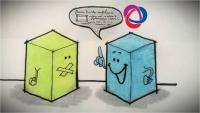Login
Our 3D CAD supplier models have been moved to 3Dfindit.com, the new visual search engine for 3D CAD, CAE & BIM models.
You can log in there with your existing account of this site.
The content remains free of charge.

Top Links
Board Info
- Board ID: 9699
- Title: BIM Glossary Of Terms and Wordings in Architecture
- Category: Architecture
- Created: 12/3/16
- 5 pins
- 1,995 views
- 0 likes
Board Details
BIM Glossary Of Terms and Wordings in Architecture
- 0 likes
- 1995 views
- 5 pins
created in Architecture
Board Content
The two words ‘information’ and ‘communication’ are often used interchangeably, but they signify quite different things. Information is giving out; communication is getting through*
As complete and accurate as a BIM model can be, at the end it is only a recipient of information, it can’t speak for himself; so in order to get the message through you need something else, you need to tell the story. BFC files do exactly that: they tell the story.
BCFZIPcomposition
BCF files tell stories about Design by providing clear communication. The way it works is by creating “issues” with “comments” written by “authors”, then adding snapshots and then linking the issue to building elements. These comments form the body of the discussion and the story of a design issue; the author field or parameter helps recreating the dialogue and the snapshots helps everyone to see the issue graphically. All of this helps design managers to keep track of issues as design evolves and gets fine tuned, and it saves time by sending a clear message about changes across disciplines.
Again, clear communication is critical as many interpretations can be given to badly modeled elements. Models can’t certainly speak for the elements that are not in place; and even with software that can differentiate new and modified elements from the rest you still need to provide a contextual argument to enrich the message and reveal the design intention. It is true as well that at some point you will have to discuss, mark up and register the changes and issues of every design iteration between trades. You already know that design coordination goes beyond clash detection, and you should know how important is to keep track of changes. BCF files also do that: they keep track of issues – regardless of software authoring platforms.
An acronym inside an acronym
BCF is an acronym for BIM Collaboration Format, and what the file format does is to store the history of design Issues as a database without storing model elements of any kind. In essence it is a list of Issues (by name) of the models, enriched with Snapshots (images), Comments (by authors) and Status, that can be linked to building elements (via GUID).
The file format is actually BCFzip not BCF and it’s based on the XML schema . It is similar to the AGCxml format for RFIs developed by the Associated General Contractors of America, the similarities may be intentional. Being XML based makes it “modular” so it can grow by adding to it without having to overwrite it completely, and it have been proved reliable and useful by the AGCA. BCFzip files can be open /saved only from a bunch of applications for now (as per May 2014) including: Tekla BIMSight, Solibri, Graphisoft ArchiCAD18, DDS-CAD natively, and by Plug-ins like KUBUS BCF Manager or Matteo Cominetti’s BCF plugin for Graphisoft ArchiCAD and Autodesk Revit and Navisworks respectively.
Was ist eine BCF-Datei?
Das BIM Collaboration Format (BCF) ist ein offenes Standardformat, das von zahlreichen Tragwerks‐, HKLSE‐ und Modellprüfprogrammen verwendet wird, um IFC‐Modellen Kommentare, Bildschirmfotos, Kamerapositionen und 3D‐Schnittebenen hinzuzufügen.
ArchiCAD unterstützt das BCF‐Format seit der Version 18 und ermöglicht so eine grössere Flexibilität bei der Verwaltung der Zusammenarbeit. Ein Beispiel ist die Lösung von Kollisionen zwischen Ihren Elementen und dazugeladenen HKLSE‐Systemen, die von anderen Softwareprogrammen wie, z. B. IFC Modell‐Checkern, erkannt und kommentiert werden.
Ein Fallbeispiel
Es findet eine Koordinationssitzung mit mehreren Planungsbeteiligten unterschiedlicher Disziplinen statt, z. B. Architekten, Fachplaner, Ingenieur, etc. Es werden Änderungen / Anpassungen anhand des 3D-Modells besprochen. Dieses ist während der Sitzung als IFC-Datei in einem Koordinationsprogramm geöffnet. Arbeitsanweisungen für die einzelnen Projektbeteiligten werden direkt im Koordinationsprogramm in kleinen Arbeitsanweisungen festgehalten (z. B. Stütze verschieben, Schacht vergrössern, etc.) und anschliessend als BCF-Dateien exportiert. Es handelt sich dabei um kleine Dateien, die auch problemlos per Mail versendet werden können. So kann im Anschluss an die Sitzung jeder in seinem Modell die relevanten Anpassungen vornehmen. Denn aus rechtlichen Gründen kann/darf z. B. der Ingenieur nicht direkt im Architekturplan Änderungen vornehmen oder umgekehrt. So bleibt jeder für sein eigenes Modell verantwortlich.
Fazit:
BCF bietet eine gute Möglichkeit, sich mit unterschiedlichen Disziplinen modellorientiert auszutauschen.
What is 5D BIM and how can it help Cost Managers add value on building information modelling (BIM) projects? Fred Mills, Co-Founder of The B1M, explains in this simple and easily digestible 5 minute video.
RELATED: WHAT WILL 5D BIM MEAN FOR COST MANAGERS?
In simple terms, BIM is the process of creating information models or data sets formed of graphical and non-graphical information in a shared digital space known as a Common Data Environment (CDE). The information builds in richness as the project stages progress until that complete data set is handed over to the Client at completion.
As you create an information model, you can add scheduling data to different components, generating accurate programme data for your project. This is known as 4D BIM. The next step is to produce accurate cost estimates from the components of the information model and it’s this process that is known as 5D BIM.
5D – The next step in the Revolution in of Construction. Paper and ink plans are 2D, CAD provides 3D, time is the 4th dimension and by attaching a schedule to each 3D object it becomes 4D. Adding financial cost data (estimated, contracted, budgeted, and actual) makes a 5D process. 5D is also a project delivery process for all phases of the construction process, virtually eliminating the need for duplication in effort, thereby drastically reducing cost and risk from the very beginning. With a 5D process potential design or construction issues can be identified early, before they become costly. A 5D platform enables an organization and their extended teams to transform their traditional methods for project delivery, over a planned period of time, into use of the BIM and VDC for enhanced abilities that create efficiencies to the project delivery process. This process has been coined as 5D project delivery as it uses the 3D intelligent data from the design processes to benefit the downstream estimating, scheduling, contract – cost – project – change – earned value management, and controlling requirements of your projects. Ultimately providing the owner organization with the ability to create and control sustainable value and operational efficiencies of the commissioned asset. From workflow and collaboration, capital planning to facilities maintenance, desktop – cloud – mobility device capabilities, the 5D software is a next generation standard for project delivery.
Expert Sees 4D, 5D BIM ‘Taking Off’
By Steve Rizer
Expect the use of 4D and 5D building information modeling (BIM) technology to flourish in the future, Turner Construction’s Treighton Mauldin told a group of construction professionals attending a webinar that WPL Publishing held April 17. He sees 4D, which addresses scheduling, and 5D, which involves estimating, “taking off because they bring all of the aspects of a plan, an estimate, a model, and a schedule into one environment that can be easily monitored and managed and communicated to the rest of the team, which is a huge benefit, and it really starts to eliminate errors in communication, miscommunication, and, in the end, makes people more money.”






